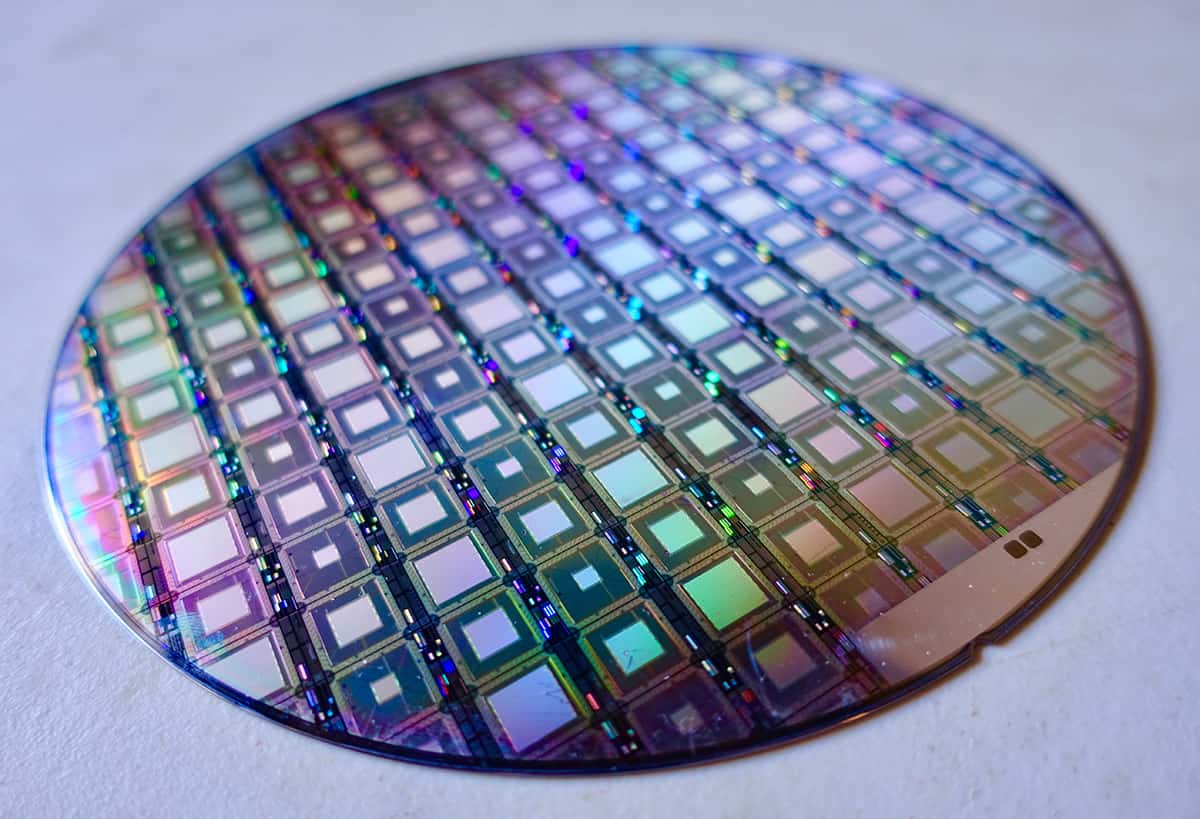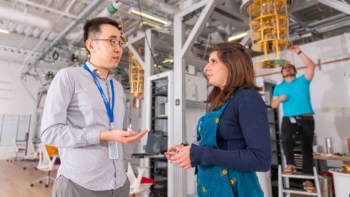From building hybrid architectures to tackling complex fundamental questions, quantum physicist Mauro Paternostro outlines the vast potential on offer from the quantum technology landscape

We are in the midst of a quantum renaissance, with researchers in academia and industry all vying to “win” the quantum computing race. The quantum marketplace is booming, with scores of companies, large and small alike, investing in this technology, backed by huge government funding across the globe.
Mauro Paternostro, a quantum physicist at the University of Palermo and Queen’s University Belfast, is an expert in quantum information processing and quantum technology. Working on the foundations of the subject, his team is doing pioneering research in cavity optomechanics, quantum communication and beyond. He is also editor in chief of the IOP Publishing journal Quantum Science and Technology.
In this wide-ranging interview, Paternostro talks to Tushna Commissariat about his views on the quantum landscape – from the “four pillars” of quantum technology and hybrid architectures to the promising marriage between quantum tech and artificial intelligence (AI). Paternostro also underlines the need for continued government funding to realize the true potential of this world-changing technology.
We’ve seen the quantum bubble blow up over the last decade, but what are the potential advantages and risks of the exponential expansion in quantum technology companies and funding around the world?
Overall, the picture is very positive. Quantum information processing needed a boost from industry, as firms can push for the more pragmatic developments that the field needs. The perspective that industry offers is helping to shape quantum technologies in a more focused manner, when it comes to overall goals. The budding, exploding market – be it in industry or academia – is great.
But, as you point out, there has been a swift growth. And while that is mostly a good thing, there is also a little bit of worry that we might be creating create a big bubble that will burst sooner rather than later. So I think it’s a matter of control – we do need to somewhat restrain ourselves, while allowing the research area to grow organically.
I am slightly concerned with the number of small companies that all seem to be developing their own quantum software. Their products have very little to do with true quantum algorithms and are typically classical optimization solutions – which have their own merits. But they are not necessarily what I would call a quantum framework.
On the other hand, some spin-off companies are more oriented towards the implementation of quantum processing platforms, such as quantum sensors. These are really interesting, as it’s not just quantum computation at play, but also other physical laws.
There are four pillars underpinning the developments of quantum technology: quantum computing; quantum simulation; quantum communication; and quantum sensing and metrology. And I would say that all four are developing in a very healthy way.
Quantum sensing seems to be one of the most advanced, together with communication thanks to the maturity of the technologies they can leverage. While the involvement of industry is beneficial and promising, we should be wary of the wild speculation and “inflation” that comes from trying to jump onto a fast bus, without having the full fare for the ride at hand.
And while I am often sceptical of smaller companies, you also sometimes get concerning news from the big players. For example, Chinese tech firm Alibaba had an interest in developing quantum computing platforms and solutions, until it suddenly decided to close its in-house quantum team at the end of last year, stating it would rather focus on being a leader in AI research.
Was this simply a business decision, or is Alibaba smelling something that we have not yet smelled? I guess we will have to wait and see. Overall, I think the future is bright and the involvement of industry is very good news.
There are a number of different quantum-computing technologies vying for top spot – from trapped ions and quantum dots to superconducting and photonic qubits. Which do you think is most likely to succeed?
I’m sort of an agnostic, in that I don’t believe that the first quantum device we build will be fully quantum. I know for some this is a controversial take, but it’s an opinion shared by many others in my field. What I think we will end up with is a hybrid architecture, where the best of high-performance computing (HPC) will interface with quantum-computing architectures.
Maybe these noisy intermediate-scale quantum (NISQ) architectures will be joined by a full-fledged HPC architecture that will boost their performance, or vice versa. The quantum resources put on the table by this sort of hybrid device will enhance the performance that current classical HPC can produce. I strongly believe in the feasibility of that sort of hybrid architecture – a fully quantum solution is still a long way from where we are now.

Also, I’m not entirely convinced that we will have the ability to manage the massive resources that would be needed to make full use of the gap in computational power that a quantum computer would offer. A medium-term goal aiming for this hybrid HPC quantum architecture will be a much more realistic – and potentially very fruitful architecture – to pursue. I’m mildly optimistic that something will come up in my lifetime.
You mentioned that quantum sensors are already being developed for a wide variety of applications including healthcare, construction and even gravity measurement. What’s new and exciting in that area?
Quantum sensors are developing amazing capabilities to investigate mechanisms that so far have been elusive. Essentially, these sensors help us to better detect the potential quantum effects of forces like gravity, which many researchers in the UK have an interest in pursuing. A substantial fraction of the experimental community is pursuing these goals – with the University of Birmingham’s quantum hub leading on this front.
I don’t think that anyone claims that there is a winning experimental platform to pursue – both cold atoms and optomechanics are some of the most promising ones in that respect. But the theoretical and experimental progress that this area has achieved is very interesting.
Sensors that can probe the fundamental nature of elusive physical mechanisms will, I believe, be a key development. And then there are other sensing devices, such as accelerometers or imagers that are already pretty well established. The UK’s National Quantum Technologies Programme has already made significant advances in that regard, and the technology is available and mature enough to have a real impact.
I think industries should heavily invest in this area because, alongside communication, sensing is at the forefront of the implementations of quantum technologies at this stage.

Setting the scene for a quantum marketplace: where quantum business is up to and how it might unfold
And what about quantum communication?
Quantum communication is probably the most concrete example where academic progress has been put to work, to the benefit of industry-led targets. It’s been an absolutely superb example of what we can achieve when these two components work together.
While the progress has been fantastic, there are also controversial aspects, especially when we consider the larger geopolitical implications of a global quantum network. The issue of communication and data security will become significant, so we must carefully consider the wider implications of these technological developments. Geopolitical boundaries are continually changing, and their aims are not always concurrent with scientific goals.
What are some key areas where AI and quantum technologies intersect? Where do they best help one another, and what are potential issues?
This is a very important question. Needless to say, the holy grail for both areas is very close – both AI and quantum computation are based on the development of new algorithms. One hears people talking about quantum machine learning (ML), or quantum AI, but that’s not what they really mean. They are not referring to specifically designed quantum algorithms for AI or ML problems. What they mean is the hybridization of classical machine learning or classical AI with quantum problems.
These solutions will depend on the field and the problem we are trying to tackle. But in general we are looking at classical techniques for processing data sets; optimizing problems; solving cost functions; and controlling, optimizing and manipulating quantum problems.
It’s very promising, as you’re putting together the best of the two worlds. From a theoretical point of view, the aim is to tackle questions at the general quantum-mechanical level that need to be addressed, and perhaps the larger and more complicated problems in terms of scale. We want to build tools at the algorithmic level that allow you to cope with the complexity of those problems in a certifiable and consolidated manner.
And the interesting thing is that experiments have started catching up with the theoretical developments. We already have a number of solutions, approaches and methodologies that have been developed in this hybrid scenario where ML and quantum information processing come together.
I hope these experiments are fully investigated in the next few years, and don’t get caught up if the AI and quantum bubble does burst. I doubt that would be the case though, because AI is here to stay, while ML is now an unmissable tool used by data analysts worldwide. If we have any ambition to scale up the complexity of the problems that we can and should tackle, then we must focus on developing these tools.
What new initiatives are going on in this area?
Earlier this year, UK Research and Innovation (UKRI) announced that it is funding nine new research hubs to “deliver revolutionary AI technologies” to tackle complex problems from healthcare to energy as well as 10 other studies to define “responsible AI”. I know that a number of these have a quantum component – especially in healthcare, where AI-based solutions are absolutely fundamental, but there may be quantum solutions as well.
So I’m very optimistic when it comes to the merger of AI and quantum tech, as long as the development of an AI framework is regulated. Right now, the European Commission is formulating the legal framework for its AI Act, which will address the risks that AI might pose, and the global role the EU hope to play in regulating the technology. Both the UK and the US have been working on similar frameworks for a while already, so we should have some global policy and regulation formulated, sooner rather than later.
As long as this development follows a regulated policy with solid framework, AI’s interactions with quantum technologies should create a useful two-way feedback mechanism that will help both fields grow significantly.
When it comes to quantum-technology funding by governments across the global stage, what specific areas would you like to see further investment in?
My grants! But on a more serious note, government-level investment has been widespread and substantial for what is essentially still an emerging scientific field. Compared with some other areas that receive science funding, such as military or medical research, the amount of money that has been put on the plate is almost ridiculous – but it’s a very good thing for us of course. A benefit of this kind of government spending is that it forces us to form a community and come up with shared goals.
If we refer to the aforementioned four pillars, there is an underlying connection of fundamental physics and theoretical developments. Different countries have chosen one or more pillar to focus on, depending on their expertise and resources. The US is very focused on computation. The EU is more widespread and so the situation is more complex, but there is major investment in communications, as well as a growing interest in simulation, while a number of EU national strategies are also focused on sensing.

The UK is also trying to cover the whole spectrum, but identifying some very well-defined topics, from imaging to computation, and from communication to sensing. There are countries like Finland that have a more experimental approach and are focused on superconducting architectures, as they already have huge facilities available. Singapore, on the other hand, is developing a very strong line of research in satellite-based quantum communication. For a small country, it has huge potential, in terms of both talent and resource.
So different countries have developed their own area of expertise, in an organic manner. And by doing so, we are all winning as a community – we are all benefiting from all the progress that has been made. Some baby steps, some more incremental steps, some huge quantum leaps.
I think it will be really important that governments, national and super national, realize that investment in quantum technologies should be sustained. It’s an area that needs continuous, unbroken support to deliver its lofty goals. And we, as the scientific community, must project a coherent picture with the very same set of goals, despite any differences we have. Only then will we be best placed to translate quantum technologies to life-changing realities.
As the new editor-in-chief of Quantum Science and Technology (QST), what’s your vision for the journal?
It’s a big honour, and I’m absolutely flattered, but it’s also a big endeavour, given the evolving landscape of quantum-related journals. What I want for the journal is to make sure that QST remains one of the preferred avenues for the submission of top-notch contributions. But I also want to help shape the journal’s manifesto and its goals.
My first priority as editor-in-chief has therefore been to set up an executive board that along with the support of the editorial board will shape the scope and mission of the journal in a clear manner. And that will then inform the way the journal will develop over the next few years, guided by the quantum research community. In terms of the scope, I would like to see more high-quality experimental updates that push the envelope of the implementation of quantum technologies.
IOP Publishing has a transformative agreement (TA) with your institution, in terms of open-access publishing. Can you tell me about that?
I think it has been a game-changing agreement as far as the publication of our output is concerned. With the stringent criteria that the research councils have put on outputs supported by grants – from the Engineering and Physical Sciences Research Council (EPSRC) for instance – and the need for them to be fully accessible, and data to be fully available to the community, having a TA that guarantees open access is what we need. It’s great to have the peace of mind that IOP Publishing is a viable avenue for where my EPSRC-compliant outputs can be published.
Apart from funding compliance, the IOPP agreement removes the administrative burden of dealing with invoices for the article publication charges (APCs) which is a big relief for the scientists. I have been advocating for broadening the initiative – by establishing similar agreements with other publishing companies – but also making sure that this is not a one-off experiment that fades away in the next year or so. We should make it systemic to the way institutions across not only UK, but as far as I’m concerned, Europe are involved. It should be encapsulated right from the start, in the way higher-education institutions and research institutes are operating. Making sure there is a synergy between publishing companies and universities or research institutes is crucial.



